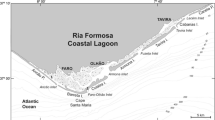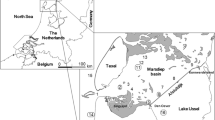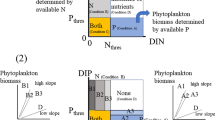Abstract
The aim of this research was to examine nutrient limitation of phytoplankton in solar salt ponds of varying salinity at Useless Inlet in Western Australia. These ponds use solar energy to evaporate seawater for the purpose of commercial salt production. A combination of techniques involving water column nutrient ratios, comparisons of nutrient concentrations to concentration of magnesium ions and bioassays were used in the investigation. Comparisons of changes in dissolved inorganic nitrogen to phosphorus ratios and concentrations of dissolved inorganic nutrients against changes in concentrations of the conservative cation Mg2+ indicated that phytoplankton biomass was potentially nitrogen limited along the entire pond salinity gradient. Nutrient addition bioassays indicated that in low salinity ponds, phytoplankton was nitrogen limited but in high salinity ponds, phosphorus limited. This may be due to isolation of phytoplankton in bioassay bottles from in situ conditions as well as to changes in phytoplankton species composition between ponds, and the variable availability of inorganic and organic nutrient sources. The differences in limiting nutrient between methods indicate that phytoplankton cells may be proximally limited by nutrients that are not theoretically limiting at the pond scale. Dissolved organic nutrients constituted a large proportion of total nutrients, with concentrations increasing through the pond sequence of increasing salinity. From the change in nutrient concentrations in bioassay bottles, sufficient dissolved organic nitrogen may be available for phytoplankton uptake in low salinity ponds, potentially alleviating the dissolved inorganic nitrogen limitation of phytoplankton biomass.






Similar content being viewed by others
References
American Public Health Association (APHA), 1998. Standard Methods for the Examination of Water and Wastewater, 20th ed. APHA, AWA & WEF, Washington, DC, USA.
Antia, N. J., P. J. Harrison & L. Olivera, 1991. The role of dissolved organic nitrogen in phytoplankton nutrition, cell biology and ecology. Phycologia 30: 1–89.
Atkinson, M. J. & S. V. Smith, 1983. C:N:P ratios of benthic marine plants. Limnology and Oceanography 28: 568–574.
Beardall, J., E. Young & S. Roberts, 2001. Approaches to determining phytoplankton nutrient limitation. Aquatic Sciences 63: 44–69.
Berman, T. & D. A. Bronk, 2003. Dissolved organic nitrogen: a dynamic participant in aquatic ecosystems. Aquatic Microbial Ecology 31: 279–305.
Bronk, D. A. & B. B. Ward, 1999. Gross and net nitrogen uptake and DON release in the euphotic zone of Monterey Bay, California. Limnology and Oceanography 44: 573–585.
Bruce, L. C., M. J. Meuleners, D. A. Horn & J. Imberger, 2000. Optimisation of Salt Production in the Shark Bay Salt Fields—Final Report. Centre for Water Research, University of Western Australia, Perth, Western Australia.
Bushaw, K. L., R. G. Zepp, M. A. Tarr, D. Schulz-Lander, R. A. Bourbonniere, R. E. Hodson, W. L. Miller, D. A. Bronk & M. Moran, 1996. Photochemical release of biologically available nitrogen from aquatic dissolved organic matter. Nature 381: 404–407.
Cotner Jr., J. B. & R. G. Wetzel, 1992. Uptake of dissolved inorganic and organic phosphorus compounds by phytoplankton and bacterioplankton. Limnology and Oceanography 37: 232–243.
Davis, J. S., 1990. Biological management for the production of salt from seawater. In Akatsuka, I. (ed.), Introduction to Applied Phycology. SPB Academic Publishing, The Hague, The Netherlands: 479–488.
Davis, J. S. & M. Giordano, 1996. Biological and physical events involved in the origin, effects and control of organic matter in solar saltworks. International Journal of Salt Lake Research 4: 335–347.
Fisher, T. R., L. W. Harding Jr., D. W. Stanley & L. G. Ward, 1988. Phytoplankton, nutrients and turbidity in the Chesapeake, Delaware and Hudson Estuaries. Estuarine, Coastal and Shelf Science 27: 61–93.
Fisher, T. R., E. R. Peele, J. W. Ammerman & L. W. Harding Jr., 1992. Nutrient limitation of phytoplankton in Chesapeake Bay. Marine Ecology Progress Series 82: 51–63.
Hecky, R. E. & P. Kilham, 1988. Nutrient limitation of phytoplankton in freshwater and marine environments: a review of recent evidence on the effects of enrichment. Limnology and Oceanography 33: 796–822.
Hecky, R. E., P. Campbell & L. L. Hendzel, 1993. The stoichiometry of carbon, nitrogen and phosphorus in particulate matter of lakes and oceans. Limnology and Oceanography 38: 709–724.
Howarth, R. W., 1988. Nutrient limitation of net primary production in marine ecosystems. Annual Review of Ecology 19: 89–110.
Joint, I., P. Henriksen, K. Garde & B. Riemann, 2002. Primary productivity, nutrient assimilation and microzooplankton grazing along a hypersaline gradient. FEMS Microbiology Ecology 39: 245–257.
Jorgensen, N. O. G., L. J. Tranvik & G. M. Berg, 1999. Occurrence and bacterial cycling of dissolved nitrogen in the Gulf of Riga, the Baltic Sea. Marine Ecology Progress Series 191: 1–18.
Karl, D. M. & K. Yanagi, 1997. Partial characterization of the dissolved organic phosphorus pool in the oligotrophic North Pacific Ocean. Limnology and Oceanography 42: 1398–1405.
McComb, A. & S. Qui, 1998. The effects of drying and reflooding on nutrient release from wetland sediments. In Williams, W. D. (ed.), Wetlands in a Dry Land: Understanding for Management. Environment Australia and Department of the Environment, Canberra, ACT, Australia: 147–159.
Nadler, A. & M. Margaritz, 1980. Studies of marine solution basins—isotopic and compositional changes during evaporation. In Nissenbaum, A. (ed.), Hypersaline Brines and Evaporitic Environments. Developments in Sedimentology 28. Elsevier Scientific Publishing Company, Amsterdam, The Netherlands: 115–129.
Pitkanen, H. & T. Tamminen, 1995. Nitrogen and phosphorus as production limiting factors in the estuarine waters of the eastern Gulf of Finland. Marine Ecology Progress Series 129: 283–294.
Post, F. J. & J. C. Stube, 1988. A microcosm study of nitrogen utilization in the Great Salt Lake, Utah. Hydrobiologia 158: 89–100.
Reuter, J. E., C. L. Rhodes, M. E. Lebo, M. Kotzman & C. R. Goldman, 1993. The importance of nitrogen in Pyramid Lake (Nevada, USA), a saline, desert lake. Hydrobiologia 267: 179–189.
Roux, J., 1991. Microbial Mats in Hypersaline Environments at Dampier Salt, Dampier, Western Australia. MSc Thesis, Botany Department, University of Western Australia, Perth, Western Australia.
Segal, R. D., 2006. Primary production and nutrient dynamics in solar salt ponds. Unpubl. Ph.D. thesis, Department of Environmental Engineering, University of Western Australia.
Seitzinger, S. P. & R. W. Sanders, 1997. Contribution of dissolved organic nitrogen from rivers to estuarine eutrophication. Marine Ecology Progress Series 159: 1–12.
Seitzinger, S. P., R. W. Sanders & R. Styles, 2002. Bioavailability of DON from natural and anthropogenic sources to estuarine plankton. Limnology and Oceanography 47: 353–366.
Selig, U., T. Hubener & M. Michalik, 2002. Dissolved and particulate phosphorus forms in a eutrophic shallow lake. Aquatic Sciences 64: 97–105.
Smith, S. V., 1984. Phosphorus versus nitrogen limitation in the marine environment. Limnology and Oceanography 29: 1149–1160.
Smith, S. V. & M. J. Atkinson, 1983. Mass balance of carbon and phosphorus in Shark Bay, Western Australia. Limnology and Oceanography 28: 625–639.
Smith, S. V. & M. J. Atkinson, 1984. Phosphorus limitation of net production in a confined aquatic ecosystem. Nature 307: 626–627.
Stenbeck, D. R., D. A. Horn & J. Imberger, 1999. Optimisation of Salt Production in the Shark Bay Salt Fields: Feasibility Report. Centre for Water Research. University of Western Australia, Perth, Western Australia.
Thompson, P. A. & W. Hosja, 1996. Nutrient limitation of phytoplankton in the upper Swan River Estuary, Western Australia. Marine and Freshwater Research 47: 659–667.
Twomey, L. J., M. F. Piehler & H. W. Paerl, 2005. Phytoplankton uptake of ammonium, nitrate and urea in the Neuse River Estuary, NC, USA. Hydrobiologia 533: 123–134.
Wetzel, R. G. & G. E. Likens, 1979. Limnological Analyses. WB Saunders Company, Philadelphia, PA, USA.
Yin, K., P.-Y. Qian, M. C. S. Wu, J. C. Chen, L. Huang, X. Song & W. Jian, 2001. Shift from P to N limitation across the Pearl River estuarine plume during summer. Marine Ecology Progress Series 221: 17–28.
Acknowledgements
This work was funded by Shark Bay Resources. RDS was supported financially by an Australian Postgraduate Award-Industry scholarship under the Australian Research Council’s Strategic Partnerships with Industry-Research and Training Scheme (No. C00107505). We thank the staff at Shark Bay Salt Joint Venture, Useless Loop, for accommodation and on-site assistance, and the Marine and Freshwater Research Laboratory, Murdoch University, for nutrient analyses. This article is CWR Research Paper ED 1923.
Author information
Authors and Affiliations
Corresponding author
Additional information
Guest Editors: J. John & B. Timms
Salt Lake Research: Biodiversity and Conservation—Selected Papers from the 9th Conference of the International Society for Salt Lake Research
Rights and permissions
About this article
Cite this article
Segal, R.D., Waite, A.M. & Hamilton, D.P. Nutrient limitation of phytoplankton in solar salt ponds in Shark Bay, Western Australia. Hydrobiologia 626, 97–109 (2009). https://doi.org/10.1007/s10750-009-9739-3
Published:
Issue Date:
DOI: https://doi.org/10.1007/s10750-009-9739-3




